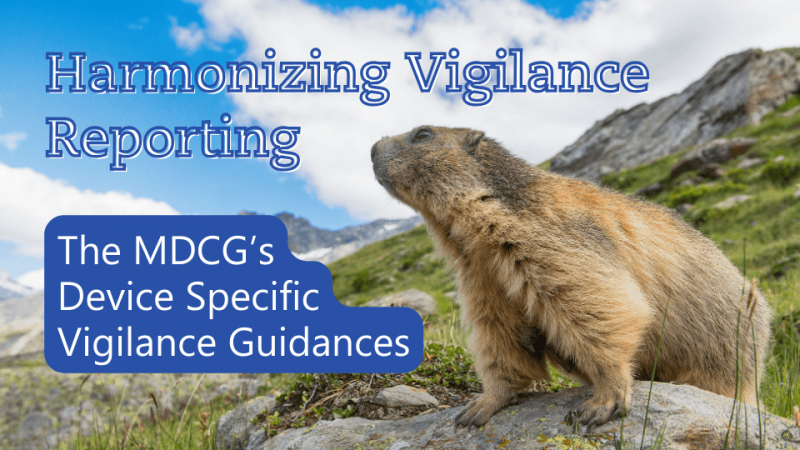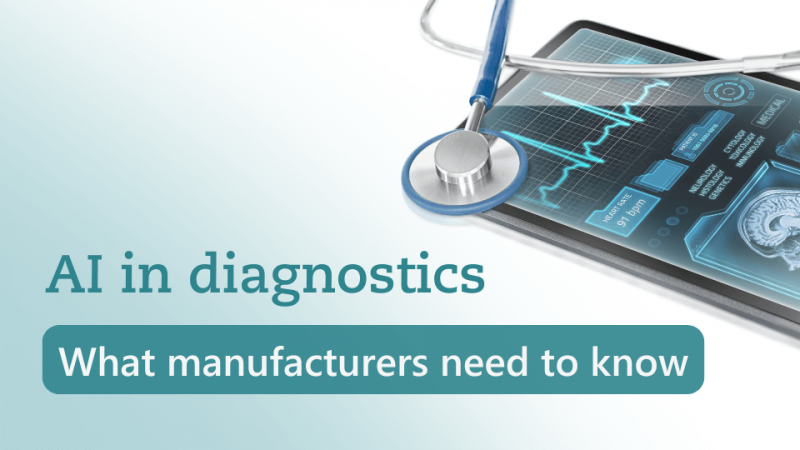Harmonizing Vigilance Reporting: A guide to the MDCG’s device specific vigilance guidances (DSVGs)
08/04/2024
Do you have any questions about the article or would you like to find out more about our services? We look forward to hearing from you!Make a non-binding enquiry now
In January 2024, the MDCG Device Specific Vigilance Guidance (DSVG) Documents were published, including both a template (MDCG 2024-1/DSVG 00) and guidances for four different devices:
How the DSVG template has changed
As we look at the MDR DSVGs, it is natural to compare them with the MDD/AIMDD DSVGs.First, we will take a look at the two DSVG templates, the template for the MDR and the template for the MDD/AIMDD. Generally speaking, the MDR DSVG template is similar to the MDD/AIMDD DSVG template. In both templates, it is explained that the guidances help to implement the requirements, and to harmonize vigilance reporting, but not to replace or extend these requirements. The MDR and MDD/AIMDD DSVG templates are also structured similarly and both templates feature a table showing the combinations of clinical symptoms or conditions and medical device problems that lead either to the reporting of a serious incident (MDR)/incident (MDD/AIMDD), to the inclusion in the periodic summary report, or to inclusion in trend reporting.Under the MDD/AIMDD, trend reporting was part of the MEDDEV 2.12-1 rev 8 before being included in its present form in the MDR. According to Article 87 (9) of the MDR a medical device manufacturer can use periodic summary reporting for similar serious incidents occurring with the same device or device type and for which the root cause has been identified, a field safety corrective action has been implemented, or where the incidents are common and well documented, if an agreement regarding the format, content, and frequency of the periodic summary reporting is in place with the coordinating competent authority in consultation with other competent authorities. When a manufacturer has no agreement on periodic summary reporting in place, then these have to be reported instead as individual serious incidents.
What has changed for specific devices
After comparing the DSVG MDR and MDD/AIMDD templates, it can be said that the medical device manufacturers who were familiar with the MDD/AIMDD DSVG templates will also likely find the transition to the MDR DSVG template straightforward.
Insulin infusion pumps and integrated meter systems
However, some differences are apparent between the MDR and MDD/AIMDD DSVGs for specific devices. First, there are only four MDR DSVGs, but there were five MDD/AIMDD DSVGs. So far, the Medical Device Coordination Group has not yet published a MDR DSVG for insulin infusion pumps and integrated meter systems and the list of ongoing MDCG documents does not indicate that this or other DSVGs are currently in the pipeline. This means that manufacturers of insulin infusion pumps and integrated meter systems must assess whether their implementation of the MDD DSVG is MDR compliant and make any changes that are necessary to align with the MDR.
A closer look at cardiac implantable electronic devices (CIEDs)
Now if we look more closely at the MDR DSVG for Cardiac implantable electronic devices (CIEDs), one change that is immediately apparent is the use of terminologies for categorized adverse event reporting as standardized by the International Medical Device Regulators Forum (IMDRF), specifically the use of the associated IMDRF Annex A (medical device problem) and Annex E (health effects – clinical signs and symptoms or conditions) codes in the MDR DSVG (MDCG 2024-1-3). This is another example where the MDCG has included the IMDRF adverse event terminologies in their guidances.The use of IMDRF adverse event terminology was already seen in the most recently published MDD/AIMDD DSVGs from 2021, but none of the other MDD/AIMDD DSVGs used IMDRF adverse event codes. The use of these codes helps to standardize information and the implementation of the DSVGs. For the CIEDs, we see an example where a given medical device problem can lead to either a serious incident or to trend reporting depending on the associated clinical symptom or condition.Specifically, the medical device problem “loss of capture/stimulation postimplant resolved by repositioning (to address a threshold rise)” (A0701) should be
Why to implement DSVGs when available
Even though the DSVGs are not exhaustive, they do provide clarity and it is advantageous for manufacturers of these devices to implement DSVGs when they are available. With the use of IMDRF adverse event terminology in each of the MDR DSVGs, it is clear that manufacturers will benefit from assigning at least some IMDRF adverse event terminology codes early enough in their vigilance workflow to enable effective use of the DSVG. Therefore, the point at which the different IMDRF adverse event codes are assigned can be a strategic decision in the fulfillment of vigilance requirements according to the MDR.While the MDR DSVGs are useful, they are unfortunately only available for a limited number of devices. However, this does not preclude manufacturers of other medical devices from using a similar approach. For example, they can identify combinations of medical device problems and clinical symptoms or conditions that must be reported as serious incidents and which may be suitable for trend reporting. Here, it is important that the manufacturers ensure they are always fully compliant with the MDR’s vigilance requirements . Even if not an exhaustive list, just like the MDR DSVGs, these guidances can help with the handling of common situations.Generally speaking, the MDR DSVGs are useful tools for the medical device manufacturers concerned. Even with these guidelines, there are important decisions to be made as to the strategic use of IMDRF codes in vigilance activities. An efficient implementation can save valuable time and ensure a consistent response.If you have questions about your MDR vigilance or post-market surveillance procedures, please give us a call. We look forward to talking with you!
- DSVG 01 on Cardiac Ablation devices (MDCG 2024-1-1),
- DSVG 02 on Coronary Stents and associated delivery systems (MDCG 2024-1-2),
- DSVG 03 on Cardiac implantable electronic devices and their leads (CIEDs) (MDCG 2024-1-3),
- DSVG 04 on Breast Implants (MDCG 2024-1-4).
How the DSVG template has changed
As we look at the MDR DSVGs, it is natural to compare them with the MDD/AIMDD DSVGs.First, we will take a look at the two DSVG templates, the template for the MDR and the template for the MDD/AIMDD. Generally speaking, the MDR DSVG template is similar to the MDD/AIMDD DSVG template. In both templates, it is explained that the guidances help to implement the requirements, and to harmonize vigilance reporting, but not to replace or extend these requirements. The MDR and MDD/AIMDD DSVG templates are also structured similarly and both templates feature a table showing the combinations of clinical symptoms or conditions and medical device problems that lead either to the reporting of a serious incident (MDR)/incident (MDD/AIMDD), to the inclusion in the periodic summary report, or to inclusion in trend reporting.Under the MDD/AIMDD, trend reporting was part of the MEDDEV 2.12-1 rev 8 before being included in its present form in the MDR. According to Article 87 (9) of the MDR a medical device manufacturer can use periodic summary reporting for similar serious incidents occurring with the same device or device type and for which the root cause has been identified, a field safety corrective action has been implemented, or where the incidents are common and well documented, if an agreement regarding the format, content, and frequency of the periodic summary reporting is in place with the coordinating competent authority in consultation with other competent authorities. When a manufacturer has no agreement on periodic summary reporting in place, then these have to be reported instead as individual serious incidents.What has changed for specific devices
After comparing the DSVG MDR and MDD/AIMDD templates, it can be said that the medical device manufacturers who were familiar with the MDD/AIMDD DSVG templates will also likely find the transition to the MDR DSVG template straightforward.Insulin infusion pumps and integrated meter systems
However, some differences are apparent between the MDR and MDD/AIMDD DSVGs for specific devices. First, there are only four MDR DSVGs, but there were five MDD/AIMDD DSVGs. So far, the Medical Device Coordination Group has not yet published a MDR DSVG for insulin infusion pumps and integrated meter systems and the list of ongoing MDCG documents does not indicate that this or other DSVGs are currently in the pipeline. This means that manufacturers of insulin infusion pumps and integrated meter systems must assess whether their implementation of the MDD DSVG is MDR compliant and make any changes that are necessary to align with the MDR.A closer look at cardiac implantable electronic devices (CIEDs)
Now if we look more closely at the MDR DSVG for Cardiac implantable electronic devices (CIEDs), one change that is immediately apparent is the use of terminologies for categorized adverse event reporting as standardized by the International Medical Device Regulators Forum (IMDRF), specifically the use of the associated IMDRF Annex A (medical device problem) and Annex E (health effects – clinical signs and symptoms or conditions) codes in the MDR DSVG (MDCG 2024-1-3). This is another example where the MDCG has included the IMDRF adverse event terminologies in their guidances.The use of IMDRF adverse event terminology was already seen in the most recently published MDD/AIMDD DSVGs from 2021, but none of the other MDD/AIMDD DSVGs used IMDRF adverse event codes. The use of these codes helps to standardize information and the implementation of the DSVGs. For the CIEDs, we see an example where a given medical device problem can lead to either a serious incident or to trend reporting depending on the associated clinical symptom or condition.Specifically, the medical device problem “loss of capture/stimulation postimplant resolved by repositioning (to address a threshold rise)” (A0701) should be- reported as a serious incident if it leads to prolonged asystole (E060101) (unless information or evaluation of the device indicates it is not device related),
- but reported at the time of a statistically significant increase in the frequency or severity of incidents (trend report according to Article 88 of the MDR) if the clinical symptom or condition is instead a pocket or other device-related infection (E1906).
Why to implement DSVGs when available
Even though the DSVGs are not exhaustive, they do provide clarity and it is advantageous for manufacturers of these devices to implement DSVGs when they are available. With the use of IMDRF adverse event terminology in each of the MDR DSVGs, it is clear that manufacturers will benefit from assigning at least some IMDRF adverse event terminology codes early enough in their vigilance workflow to enable effective use of the DSVG. Therefore, the point at which the different IMDRF adverse event codes are assigned can be a strategic decision in the fulfillment of vigilance requirements according to the MDR.While the MDR DSVGs are useful, they are unfortunately only available for a limited number of devices. However, this does not preclude manufacturers of other medical devices from using a similar approach. For example, they can identify combinations of medical device problems and clinical symptoms or conditions that must be reported as serious incidents and which may be suitable for trend reporting. Here, it is important that the manufacturers ensure they are always fully compliant with the MDR’s vigilance requirements . Even if not an exhaustive list, just like the MDR DSVGs, these guidances can help with the handling of common situations.Generally speaking, the MDR DSVGs are useful tools for the medical device manufacturers concerned. Even with these guidelines, there are important decisions to be made as to the strategic use of IMDRF codes in vigilance activities. An efficient implementation can save valuable time and ensure a consistent response.If you have questions about your MDR vigilance or post-market surveillance procedures, please give us a call. We look forward to talking with you!
Our blog posts are researched and created with the utmost care, but are only snapshots of the regulations, which are constantly changing. We do not guarantee that older content is still current or meaningful. If you are not sure whether the article you have read on this page still corresponds to the current state of regulation, please contact us: we will quickly place your topic in the current context.



